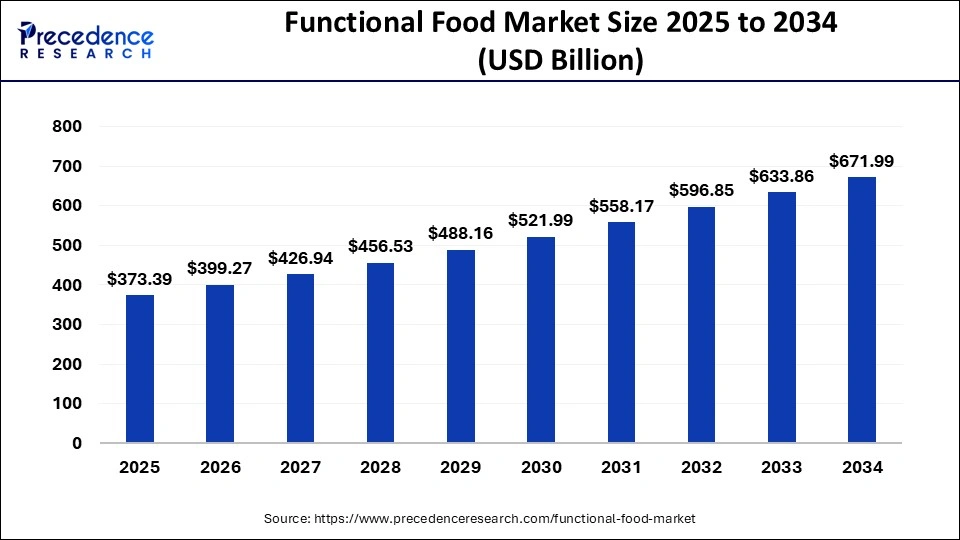The global functional food market, valued at USD 349.20 billion in 2024, is set to reach USD 671.99 billion by 2034, growing at a CAGR of 6.93%.
Functional Food Market Key Takeaways
- Asia Pacific captured over 36% of the functional food market revenue in 2024.
- The carotenoids segment is projected to grow at a CAGR of 7.4% from 2025 to 2034.
- Vitamin-based functional foods are expanding at a CAGR of 7.1%.
- Dairy products led the market with a 39% revenue share in 2024.
- Bakery and cereals accounted for 27% of the market revenue in 2024.
The global functional food market is witnessing significant growth, driven by increasing consumer awareness of health and wellness. Valued at USD 349.20 billion in 2024, the market is expected to reach USD 671.99 billion by 2034, expanding at a CAGR of 6.93%. The Asia Pacific region dominates the market, holding over 36% of the revenue share in 2024. Ingredient-wise, the carotenoids segment is growing at a CAGR of 7.4% from 2025 to 2034, while vitamin-based functional foods are expanding at a CAGR of 7.1%.
Among product categories, dairy products led the market with a 39% revenue share in 2024, followed by the bakery and cereals segment, which accounted for 27% of total revenue. Rising demand for fortified foods, increasing consumer preference for natural and organic ingredients, and growing investments in the functional food industry are key factors propelling market expansion.
Sample Link: https://www.precedenceresearch.com/sample/1094
Key Drivers
The functional food market is driven by growing consumer awareness regarding health and wellness, leading to a rising demand for fortified and nutrient-rich foods. Increasing prevalence of chronic diseases such as obesity, diabetes, and cardiovascular disorders has fueled the need for functional foods that offer health benefits beyond basic nutrition. The expanding aging population worldwide is also contributing to market growth, as older consumers seek products that support immunity, digestion, and overall well-being. Advancements in food technology and ingredient innovation, particularly in probiotics, prebiotics, and bioactive compounds, are further propelling market expansion.
The shift toward clean-label, organic, and plant-based products, along with growing disposable incomes and changing dietary habits, is encouraging consumers to opt for functional foods. Additionally, supportive government regulations and initiatives promoting food fortification are boosting industry growth, while increasing investments in research and development are enhancing product offerings in the market.
Opportunities
- Rising demand for plant-based and organic functional foods.
- Expansion of e-commerce and direct-to-consumer sales channels.
- Increasing investments in research and development for innovative ingredients.
- Growing consumer interest in personalized nutrition and functional beverages.
- Government initiatives promoting food fortification and health awareness.
- Emerging markets in Asia-Pacific and Latin America present high growth potential.
Challenges
- High production costs associated with functional food ingredients.
- Stringent regulatory requirements and approval processes.
- Consumer skepticism regarding product efficacy and health claims.
- Supply chain disruptions affecting raw material availability.
- Intense market competition leads to pricing pressure.
- Limited consumer awareness in developing regions.
Regional Insights
The Asia Pacific region dominates the functional food market, accounting for over 36% of the revenue share in 2024, driven by rising health consciousness, increasing disposable income, and a growing demand for fortified foods in countries like China, India, and Japan. North America follows closely, with strong market growth fueled by high consumer awareness, a well-established food industry, and a significant demand for protein-enriched and probiotic-based products.
The presence of key market players and continuous product innovations further support growth in the region. Europe also holds a substantial share, with increasing adoption of functional foods due to stringent regulations promoting clean-label and organic products, along with a rising preference for plant-based and vitamin-fortified foods. Meanwhile, Latin America and the Middle East & Africa are emerging markets with growing potential, as improving economic conditions, urbanization, and increasing health awareness contribute to the rising demand for functional food products in these regions.
Don’t Miss Out: Plasma Pulse Technology Market
Market Key Players
- Standard Functional Foods Group Inc.
- Coca-Cola Co.
- GFR Pharma
- Nutri-Nation
- KFSU
- Amway
- Herbalife
- Arla Foods
Recent News
The functional food market is experiencing significant growth, driven by consumer demand for health-enhancing products. In 2025, the market is projected to reach approximately USD 595.49 billion, expanding at a CAGR of 6.5% from 2025 to 2033. A notable trend is the resurgence of nostalgic brands with a health-focused twist. For instance, Slice, a soda brand from the 1980s, has been reintroduced with added prebiotics, probiotics, and postbiotics, aligning with the growing popularity of functional beverages.
Major retailers are also entering the functional food sector. Marks & Spencer has launched a range of drinks infused with adaptogenic mushrooms, such as lion’s mane and reishi, aimed at enhancing cognitive function and reducing stress. Additionally, the market is witnessing a surge in products that combine indulgence with health benefits. This includes the development of functional snacks and beverages that cater to consumers seeking both taste and wellness.
Market Segmentation
By Product
- Dairy Products
- Bakery & Cereals
- Meat, Fish & Eggs
- Fats & Oils
- Soy Products
- Others
By Ingredient
- Dietary Fibers
- Carotenoids
- Minerals
- Fatty Acids
- Vitamins
- Prebiotics & Probiotics
- Others
By Application
- Weight Management
- Sports Nutrition
- Digestive Health
- Immunity
- Cardio Health
- Clinical Nutrition
- Others


